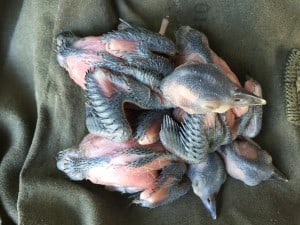Share this article
Red-cockadeds Peck Their Way Through N.C. Longleaf Pines
About the size of a bluebird, the federally endangered red-cockaded woodpecker is approximately 7 inches long, with black and white horizontal stripes across its back. The red-cockaded woodpecker’s most distinguishing feature is its large white cheek patches. Only the male of the species has a small red streak on each side of its black cap which is called a cockade.
The red-cockaded woodpecker makes its home in mature pine forests across the Southeastern United States. Longleaf pines (Pinus palustris) are commonly preferred, but other species of southern pine are also used. While other woodpeckers bore out cavities in dead trees, the red-cockaded woodpecker is the only bird which excavates cavities exclusively in living pine trees. Cavities generally take several years to excavate.
Red-cockaded woodpeckers are territorial, non-migratory, cooperative breeders. They live in family groups which usually contain a breeding pair and one or more helpers which are usually male offspring raised in previous years. Juvenile females generally leave the group before the next breeding season, in search of solitary males. In the spring, the breeding female lays three to four eggs in the breeding male’s roost cavity. Once the eggs are laid, all group members take turns incubating the small white eggs for approximately 11 days. Once hatched, the nestlings remain in the nest cavity for about 26 days. Upon fledging, the young often remain with the parents for several months. There is only one pair of breeding birds within each group, and they normally raise only a single brood each year.
Historically, this woodpecker’s range extended from Florida to New Jersey, as far west as Texas and Oklahoma, and inland to Missouri, Kentucky, and Tennessee. Today it is estimated that there are about 7,200 groups of red-cockaded woodpeckers from Florida to Virginia and west to eastern Texas.
The red-cockaded woodpecker plays a vital role in the intricate web of life of the southern pine forests. A number of other birds and small mammals use the cavities excavated by red-cockaded woodpeckers, such as chickadees, bluebirds, titmice, and several other woodpecker species, including the downy, hairy, and red-bellied woodpecker. Larger woodpeckers may take over a red-cockaded woodpecker cavity, sometimes enlarging the hole enough to allow screech owls, wood ducks, and kestrels to later move in. Flying squirrels, several species of reptiles and amphibians, and insects, primarily bees and wasps, also will use red-cockaded woodpecker cavities.
The 2016 TWS Conference will feature a field trip to the Walthour-Moss Foundation in the Sandhills region of North Carolina where participants will be able to walk among the longleaf pines and native wiregrass and see red-cockaded woodpecker habitat including cavity trees.
Header Image: ©Andy Reago & Chrissy McClarren, licensed by cc 2.0









